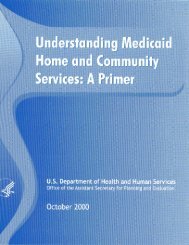STRATEGIC PLAN - ASPE - U.S. Department of Health and Human ...
STRATEGIC PLAN - ASPE - U.S. Department of Health and Human ...
STRATEGIC PLAN - ASPE - U.S. Department of Health and Human ...
Create successful ePaper yourself
Turn your PDF publications into a flip-book with our unique Google optimized e-Paper software.
CHAPTER 3: Public <strong>Health</strong> Promotion <strong>and</strong> Protection, Disease Prevention,<strong>and</strong> Emergency PreparednessZoonotic 7 /Vectorborne DiseasesTo address zoonotic <strong>and</strong> vectorborne diseases, HHSwill develop plans to respond to a disease outbreakthat encompasses animal, vector, <strong>and</strong> human expertsworking in synergy. CDC will develop diseasesurveillance systems that incorporate animal, vector,<strong>and</strong> human data to provide an effective public healthresponse that will mitigate the impact <strong>of</strong> a multispeciesoutbreak. CDC will develop, test, <strong>and</strong> deploy improvedmethods for the detection <strong>and</strong> control <strong>of</strong> insectborneviruses <strong>and</strong> bacteria <strong>and</strong> will improve the capacity todetect the intentional release <strong>of</strong> plague, Rabbit Fever(tularemia), <strong>and</strong> other agents with bioterror potential.FDA will foster the development <strong>of</strong> preventive vaccinesfor malaria, dengue fever, <strong>and</strong> other vector-borne<strong>and</strong> zoonotic diseases by working with industry <strong>and</strong>academia. In addition, surveillance, detection, <strong>and</strong>response systems will be developed <strong>and</strong> tested toaddress domestic <strong>and</strong> international epidemics <strong>of</strong>vectorborne pathogens with the potential to harm theU.S. population.Foodborne/Waterborne IllnessesTo combat foodborne illness, FDA <strong>and</strong> CDC willwork together to protect public health throughpreventive strategies that improve surveillance,inspection, tracking, detection, investigation,control, <strong>and</strong> prevention <strong>of</strong> foodborne outbreaks <strong>and</strong>disease; strengthen the enforcement <strong>of</strong> regulations;<strong>and</strong> broaden education about these problems. HHSwill improve the important national collaborativesurveillance <strong>and</strong> response networks <strong>of</strong> the FoodNet,PulseNet, <strong>and</strong> OutbreakNet to make them faster,more responsive, <strong>and</strong> capable <strong>of</strong> more detailedinvestigations. FDA <strong>and</strong> CDC, along with the U.S.<strong>Department</strong> <strong>of</strong> Agriculture, <strong>and</strong> other organizations,will continue to participate in the Council to ImproveFoodborne Outbreak Response, a group created todevelop tools that facilitate the investigation <strong>and</strong>control <strong>of</strong> foodborne disease outbreaks. Over thenext several years, the Council will develop multistate7 Zoonotic diseases are caused by infectious agents (such asmosquitoes) that can be transmitted between (or are shared by)animals <strong>and</strong> humans.outbreak guidelines, a repository for resources <strong>and</strong>tools, <strong>and</strong> performance indicators for the response toenteric disease.To address waterborne diseases, CDC will continue topartner with EPA to fill critical data gaps by providingimproved disease surveillance data, creating evidencebasedguidelines <strong>and</strong> training for investigations,exp<strong>and</strong>ing access to water-related information,collecting data to define the magnitude <strong>and</strong> burden<strong>of</strong> waterborne illness, evaluating water-relatedinterventions to improve public health, <strong>and</strong> developinglaboratory sampling <strong>and</strong> detection methodologies. Aspart <strong>of</strong> its preparedness effort, CDC will also develop,improve, <strong>and</strong> deploy rapid sampling <strong>and</strong> detectionmethods for potential waterborne threats. Providingcomprehensive public health protection to allcommunity users <strong>of</strong> water will create a more effectiveFederal response aimed at reducing the burden <strong>of</strong>waterborne disease in the United States.Global <strong>Health</strong>One key strategy for preventing the spread <strong>of</strong> infectiousdisease is preventing it from reaching the UnitedStates. HHS will collaborate with the World <strong>Health</strong>Organization (WHO) <strong>and</strong> other international partnersto provide epidemiologic <strong>and</strong> laboratory support toassist countries in addressing disease threats throughimproved disease detection. HHS also will provideprogrammatic expertise, training, <strong>and</strong> funding supportto assist with surveillance, control, elimination, <strong>and</strong>eradication activities for diseases such as measles,polio, avian influenza, <strong>and</strong> HIV/AIDS, as well as theprovision <strong>of</strong> technical assistance with safe <strong>and</strong> healthywater <strong>and</strong> improved sanitation.Immunization has revolutionized child health incountries throughout the world. WHO estimates thatalmost 40 percent <strong>of</strong> child deaths for children youngerthan 5 years <strong>of</strong> age are potentially preventable byvaccines. xxi HHS has been a major supporter <strong>of</strong> globalinitiatives to eradicate polio; control measles; <strong>and</strong>introduce new vaccines for pneumoccocal diseases,rotavirus, <strong>and</strong> possibly in the near future, malaria<strong>and</strong> even HIV. HHS remains committed to achieving64 HHS Strategic Plan FY 2007-2012
















